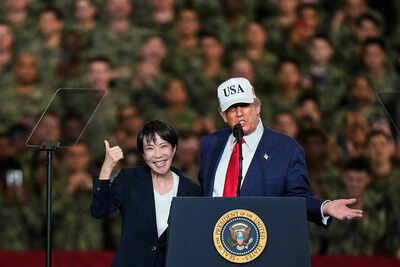
Japanese Prime Minister Sanae Takaichi gestures as U.S. President Donald Trump delivers his speech during their visit to the aircraft carrier USS George Washington at the U.S. Navy's Yokosuka base in Yokosuka, south of Tokyo, Tuesday, Oct. 28, 2025. (AP Photo/Eugene Hoshiko)
Donald Trump’s flair for bold declarations collided with Toyota’s characteristic restraint this week. During his visit to Japan, the US president announced that Toyota Motor was readying an investment “to the tune of over $10 billion” in the United States — a statement swiftly contradicted by the automaker itself.
The episode has reignited discussion not only about political theatrics but also about the enduring imbalance between US and Japanese car markets, where American vehicles struggle to gain traction while Japanese brands dominate globally.
Toyota’s response: A correction, not a confrontation
Toyota moved quickly to clarify that no such promise had been made. “During the first Trump administration, I think the figure was roughly around $10 billion, so while we didn’t say the same scale, we did explain that we’ll keep investing and providing employment as before.
So, probably because of that context, the figure of about $10 billion came up,” said Masahiko Ueda, a senior Toyota executive, speaking on the sidelines of the Japan Mobility Show in Tokyo.
“Therefore, we didn’t specifically say that we’ll invest $10 billion over the next few years.” Ueda also added that the topic of investment “did not come up when Toyota Chairman Akio Toyoda briefly spoke to Trump at a US Embassy event on Tuesday evening,” according to Reuters.
Toyota confirmed that while it remains committed to investing and creating jobs in the United States, there was no explicit commitment of the magnitude Trump had claimed.
Trump’s Japan visit: Optics, symbolism, and salesmanship
Trump’s remarks came during a high-profile trip to Japan, where he met the country’s new and first female prime minister, Sanae Takaichi. He hailed her pledge to accelerate Japan’s military build-up and the signing of new trade and rare-earth mineral agreements between the two nations.
Takaichi, for her part, promised to usher in a “golden age” of US-Japan relations and “fundamentally reinforce” Japan’s defence posture. At a US naval base in Yokosuka, Trump addressed American troops aboard the USS George Washington, urging them to “go out and buy a Toyota.” He told service members: “They’re going to be putting auto plants all over the United States to the tune of $10 billion. So that’s Toyota, so go out and buy a Toyota.” In a symbolic gesture that blended diplomacy with automotive theatre, Trump was greeted in Tokyo by an enormous American-made Ford F-150 truck, a nod to a proposal within Japan’s government to buy a fleet of the vehicles. “She has good taste,” Trump quipped of Prime Minister Takaichi. “That’s a hot truck.”
An uneven playing field: Japan’s auto dominance
Beyond the theatrics lies the long-standing asymmetry between Japan’s thriving exports to America and the near-invisibility of US cars on Japanese roads. In 2024, Japan exported over 1.37 million vehicles to the United States, according to the Japan Automobile Manufacturers Association, cars remain the nation’s top export to America. Yet Japan imported fewer than 17,000 American vehicles that same year, per the Japan Automobile Importers Association. The gap is glaring but not new. Japan’s urban density, narrow streets, and compact parking spaces make smaller, fuel-efficient models far more practical. Large, heavy-duty American trucks and SUVs, by contrast, are an awkward fit. Even among affluent consumers who can afford imports, most opt for European makes like Mercedes-Benz, BMW, Volkswagen, or Audi. Former Prime Minister Shigeru Ishiba put it bluntly in parliament earlier this year: “Why don’t American cars sell well in Japan? Because they lack understanding for road conditions and housing situations, as well as energy conservation.” Recent data from the Japan Automobile Dealers Association (JADA), published 4 April 2025, shows just how skewed the domestic market is. Japanese manufacturers accounted for 93 per cent of all car sales in March 2025. More than half — 52.1 per cent — were small or light passenger cars, segments that US automakers do not produce for Japan. Toyota, Honda and Suzuki together hold 62.1 per cent of the market. About 40 per cent of all new cars sold are the ultra-compact Kei cars, such as those by Suzuki and Daihatsu, vehicles tailored for Japan’s space-constrained environment.“In Japan, there is a different market and different consumer,” said Kristin Dziczek, vice-president of industry, labour & economics at the Center for Automotive Research. “Although US autos aren’t taxed going into Japan, American cars aren’t made for Japanese consumers. We are giving them our off-cast, things we make for the North American consumer that we hope we can then sell in other markets.” European automakers have succeeded precisely because they adapted. They invested in right-hand-drive models and local service networks. American firms lagged behind. Most US cars remain left-hand drive, a daily inconvenience in a country that drives on the left.
The exception is Fiat Chrysler’s Jeep, whose rugged image resonates with Japanese buyers seeking a taste of Americana. The Jeep Wrangler, a symbol of outdoor adventure, dominates that niche.
In 2024, European automakers sold over 100,000 vehicles in Japan: Mercedes-Benz (53,195 units), BMW (35,240), Volkswagen (22,779), and Audi (21,415). Jeep sold 9,633, while General Motors and Ford together barely passed a thousand.
Ford, in fact, withdrew from Japan in 2017. Meanwhile, Japanese makers flourish across the Pacific. Toyota alone sold over 2.3 million vehicles in the United States in 2024, making it the nation’s second-largest carmaker. The imbalance is stark: Japan fills US roads, while US cars scarcely register in Japan.
A road that still runs one way
Cultural and infrastructural realities keep the divide intact. Japanese consumers prize efficiency, compactness, and reliability, attributes embodied by their homegrown brands.
US cars, often larger and less fuel-conscious, remain misaligned with local expectations. Even enthusiasts who appreciate American classics worry about maintenance, spare parts, and servicing. Some US manufacturers are trying to adjust. General Motors now offers a right-hand-drive version of its eighth-generation Chevrolet Corvette, signalling belated recognition of Japan’s needs. But the impact is marginal.
Jeep’s 0.2 per cent market share is still the highest for any US marque, and no American model cracks Japan’s top-50 best-sellers. The numbers tell their own story. About 95 per cent of cars on Japanese roads are Japanese-made. Imports occupy the remaining sliver, mostly European. The US footprint is microscopic, limited to niche collectors of vintage Cadillacs or Chevrolets. Trump’s exaggerated claim, then, isn’t merely a political misstep, it’s emblematic of a broader truth. The automotive relationship between America and Japan has never been one of equals. One builds cars the world buys; the other struggles to sell its own beyond its borders. Toyota’s polite correction to Trump’s boast underscores that reality: for all the talk of new investment, the road between Detroit and Tokyo still runs mostly one way.

 6 hours ago
2
6 hours ago
2










 English (US) ·
English (US) ·